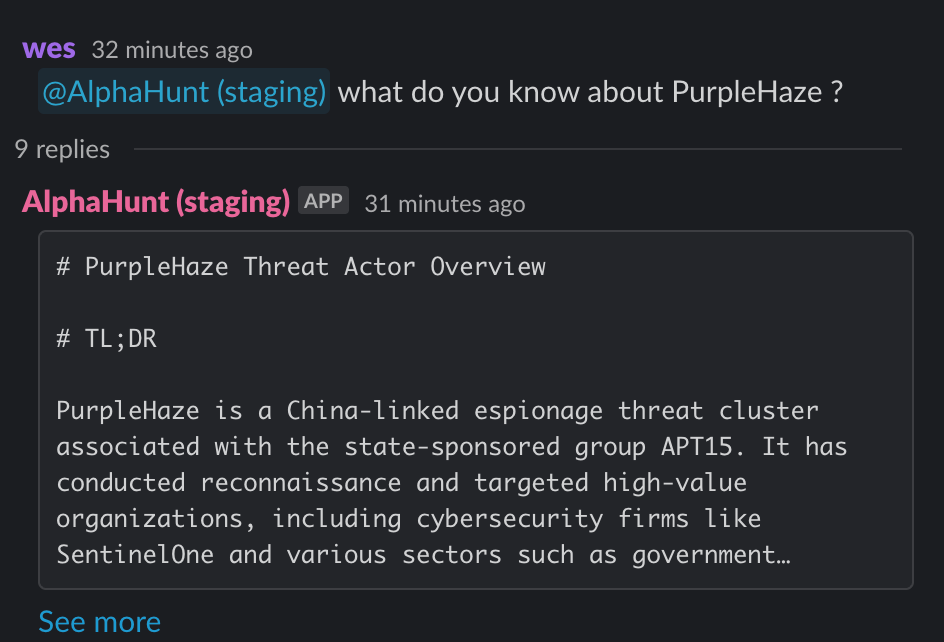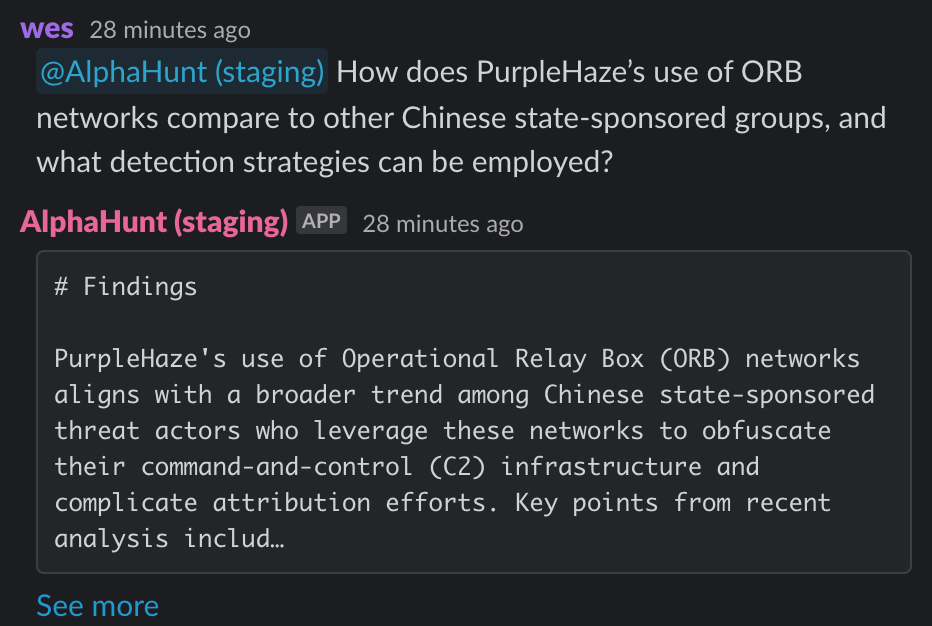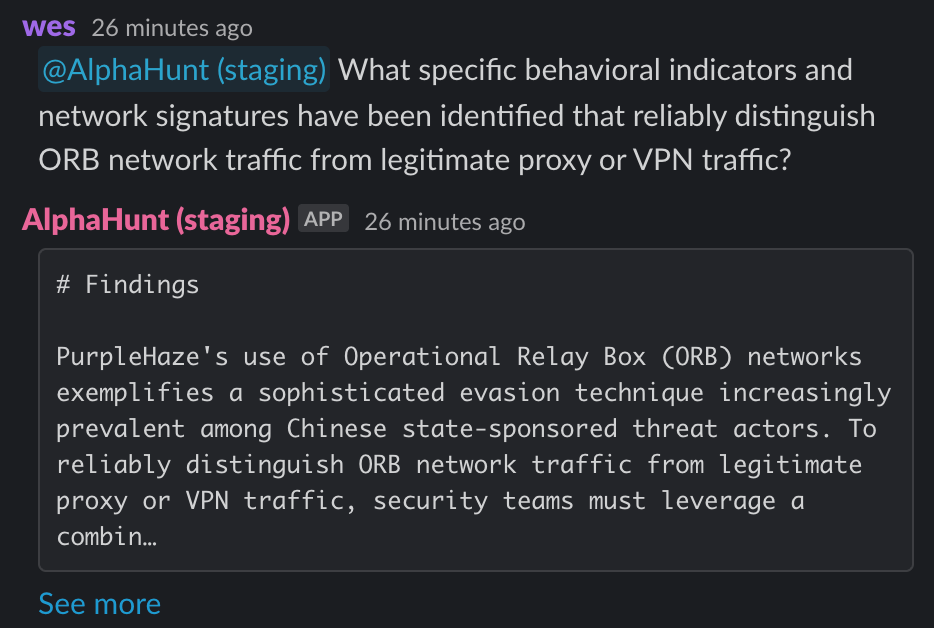PurpleHaze’s Dynamic ORB Networks: Advanced Tactics, Detection Challenges, and Mitigation Strategies
PurpleHaze, an emerging Chinese state-sponsored threat group, operates highly dynamic multi-hop ORB networks that blend compromised IoT devices (notably SOHO routers with vulnerable firmware) and provisioned VPS to obscure command-and-control (C2) infrastructure.





did i lose you?
(Have feedback? Did something resonate with you? Did something annoy you? Just hit reply! :))
Get questions from your boss, like this:
- what do you know about PurpleHaze ?
- How does PurpleHaze’s use of ORB networks compare to other Chinese state-sponsored groups, and what detection strategies can be employed?
- What specific behavioral indicators and network signatures have been identified that reliably distinguish ORB network traffic from legitimate proxy or VPN traffic?
Are you ready to level up your skillset? Get Started Here!
Suggested Pivot
How does PurpleHaze’s use of ORB networks compare to other Chinese state-sponsored groups, and what detection strategies can be employed?
TL;DR
Key Points
-
- PurpleHaze leverages multi-hop Operational Relay Box (ORB) networks, combining compromised IoT devices and provisioned VPS, with advanced obfuscation and dynamic node cycling to evade detection.
- Prioritize patching and hardening of internet-facing SOHO routers and IoT devices, especially those with known vulnerabilities (e.g., Zyxel VMG3625-T20A).
-
- Detection is complicated by proprietary obfuscation (ScatterBrain), unique TLS certificate issuer fields, reverse SSH tunnels (GoReShell), and mixed legitimate/malicious traffic.
- Deploy tailored Sigma, YARA, and SIEM rules to identify custom SSH banners, obfuscated payloads, and multi-hop proxy traffic on uncommon ports.
-
- PurpleHaze’s tactics diverge from other Chinese APTs (e.g., APT31, APT5/15) through higher IoT device reliance, dynamic relay chains, and integration of ransomware with espionage.
- Integrate behavioral analytics to flag cross-geographic device communications, sudden device patching, and hybrid attack indicators.
-
- Incident response requires updated playbooks, credential hygiene (MFA, rotation, monitoring for dumping/manipulation), and rapid containment of affected devices.
- Regularly update response procedures and enforce strict credential management using LAPS/PIM.
-
- Forecasts indicate continued expansion of ORB networks, increased use of AI-driven detection, and regulatory pressure on IoT security.
- Invest in AI/ML analytics for real-time anomaly detection and align asset management with emerging IoT security standards.
Executive Summary
PurpleHaze, an emerging Chinese state-sponsored threat group, operates highly dynamic multi-hop ORB networks that blend compromised IoT devices (notably SOHO routers with vulnerable firmware) and provisioned VPS to obscure command-and-control (C2) infrastructure. Their operations are characterized by the use of Go-based reverse SSH backdoors (GoReShell), proprietary obfuscation layers (ScatterBrain), and distinctive TLS certificate issuer fields, making traditional detection and attribution highly challenging.
Behavioral indicators include irregular cross-geographic device communications, sudden device patching/cleanup to remove competing malware, and the routing of both legitimate and malicious traffic through ORB nodes. PurpleHaze’s infrastructure is more ephemeral and IoT-centric than that of peer Chinese APTs, with frequent node cycling and integration of ransomware delivery in select campaigns.
Detection and mitigation require a multi-layered approach: patching and hardening of exposed network devices, deployment of custom detection rules (Sigma, YARA, SIEM), and enhanced behavioral analytics to identify anomalous relay patterns and device behaviors. Incident response playbooks must be updated to address ORB-specific tactics, including rapid isolation, credential hygiene, and monitoring for hybrid espionage/ransomware activity.
Short-term forecasts predict increased exploitation of vulnerable IoT devices, persistent detection challenges due to advanced obfuscation, and greater adoption of behavioral analytics in SOCs. Long-term, expect global expansion of ORB networks, AI-driven detection models, convergence of Chinese APT tactics, and regulatory initiatives to improve IoT security. Technical defenders should focus on continuous vulnerability management, advanced analytics, and cross-organizational intelligence sharing to counter these evolving threats.
Research
Technical Depth on PurpleHaze’s ORB Network Operations:
- PurpleHaze employs multi-hop ORB networks combining provisioned VPS and compromised IoT devices, including routers with specific firmware versions (e.g., Zyxel VMG3625-T20A).
- Network signatures include:
- Use of reverse SSH tunnels (GoReShell backdoor) with customized SSH banners and ephemeral session keys.
- Distinctive X.509 certificates in TLS sessions with unique issuer fields linked to ORB infrastructure.
- Timing patterns showing irregular intervals in multi-hop relay communications, often with randomized delays to evade detection.
- Packet-level characteristics include encrypted payloads with proprietary obfuscation layers and use of uncommon TCP/UDP ports for C2 traffic.
- Behavioral indicators:
- Unusual cross-geographic device communications, such as SOHO routers in disparate countries communicating directly.
- Sudden patching or cleanup of compromised devices by threat actors to remove competing malware and avoid detection.
- Mixed legitimate and malicious traffic routed through ORB nodes, complicating anomaly detection.
Comparative Analysis with Other Chinese State-Sponsored Groups:
- PurpleHaze vs. APT31:
- PurpleHaze uses Go-based backdoors (GoReShell) and ScatterBrain obfuscation, while APT31 relies more on web shells and Java-based payloads.
- PurpleHaze’s ORB networks show a higher reliance on compromised IoT devices in Southeast Asia, whereas APT31’s infrastructure is more VPS-heavy and geographically diverse.
- PurpleHaze employs dynamic multi-hop relay chains with reverse SSH tunnels; APT31 uses more static proxy chains and TOR relays.
- PurpleHaze vs. APT5/15:
- APT5/15 operate provisioned ORB networks (e.g., ORB3/SPACEHOP) with known exploitation of CVE-2022-27518.
- PurpleHaze’s infrastructure is more ephemeral, with frequent node cycling and device patching post-compromise.
- PurpleHaze integrates ransomware delivery in some campaigns, diverging from APT5/15’s primarily espionage-focused operations.
Prioritized Mitigation and Incident Response Recommendations Mapped to MITRE ATT&CK:
- T1190 - Exploit Public-Facing Application: Harden and patch internet-facing services to prevent initial access.
- T1078 - Valid Accounts: Monitor and restrict use of valid credentials; implement MFA.
- T1505.003 - Server Software Component: Web Shell: Detect and block web shell deployments.
- T1090.003 - Proxy: Multi-hop Proxy: Monitor for multi-hop proxy traffic patterns.
- T1059.001 - Command and Scripting Interpreter: PowerShell: Enable PowerShell logging and analyze for anomalies.
- T1560.001 - Archive Collected Data: Detect unusual data staging and archiving.
- T1046 - Network Service Scanning: Detect reconnaissance activities.
- T1021.001 - Remote Services: SMB: Monitor lateral movement over SMB.
- T1071.001 - Application Layer Protocol: Web Protocols: Inspect web protocol traffic for C2.
- T1562.001 - Impair Defenses: Disable or Modify Tools: Detect tampering with security tools.
- T1055 - Process Injection: Monitor for process injection behaviors.
- T1134.001 - Access Token Manipulation: Detect token theft or impersonation.
- T1003.002 - OS Credential Dumping: Monitor for credential dumping.
- T1570 - Lateral Tool Transfer: Detect unauthorized tool transfers.
- T1048 - Exfiltration Over Alternative Protocol: Monitor for data exfiltration via uncommon protocols.
Example Detection Rules and Queries:
- Sigma rule for detecting reverse SSH tunnels with unusual banner strings:
title: Detect Reverse SSH Tunnel with Custom Banner
logsource:
product: network
service: ssh
detection:
selection:
ssh_banner|contains: ["GoReShell", "reverse_ssh"]
condition: selection
level: high
- YARA rule snippet for ScatterBrain-obfuscated ShadowPad:
rule ScatterBrain_ShadowPad {
strings:
$a = { 6A 40 68 ?? ?? ?? ?? 6A 14 8D 91 }
$b = "ScatterBrain"
condition:
$a and $b
}
- SIEM query example to detect multi-hop proxy traffic:
index=network_traffic
| stats count by src_ip, dest_ip, dest_port
| where dest_port in (uncommon_ports_list)
| join type=inner [search index=network_traffic | stats count by src_ip, dest_ip]
| where src_ip != dest_ip
Engagement and Clarity Enhancements:
- Case Example: In late 2024, PurpleHaze targeted a South Asian government entity using an ORB network with GoReShell backdoors, enabling stealthy reconnaissance and data exfiltration. The multi-hop relay infrastructure masked the attacker’s origin, delaying detection and complicating incident response.
- Hypothetical Scenario: An enterprise detects unusual SSH traffic with custom banners and irregular timing patterns. Behavioral analytics flag multi-hop relay communications involving IoT devices in disparate regions. Incident responders correlate these with threat intelligence on PurpleHaze’s ORB tactics, enabling rapid containment and mitigation.
Recommendations, Actions, Suggested Pivots, Forecasts and Next Steps..
(Subscribers Only)



![[DEEP RESEARCH] Token Factory: The 5 Costliest US Breaches of 2025](/content/images/size/w600/2026/01/z.png)

